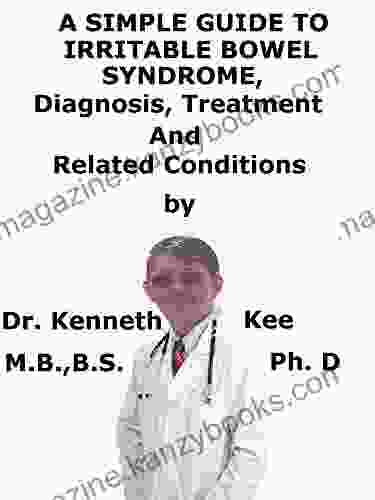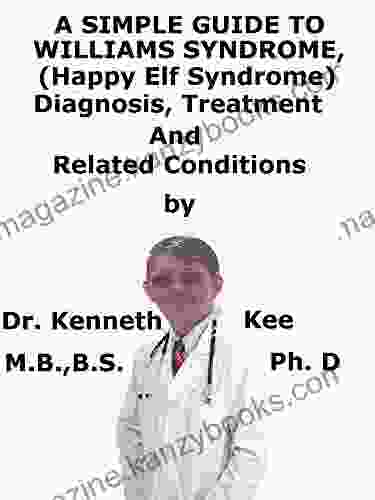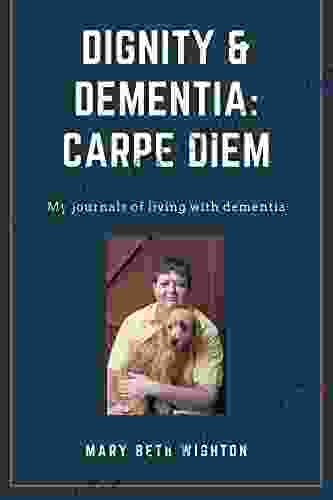Simple Guide to Williams Syndrome: Happy Elf Syndrome Diagnosis, Treatment, and Beyond

4.9 out of 5
| Language | : | English |
| File size | : | 392 KB |
| Text-to-Speech | : | Enabled |
| Enhanced typesetting | : | Enabled |
| Word Wise | : | Enabled |
| Print length | : | 82 pages |
| Lending | : | Enabled |
| Screen Reader | : | Supported |
: Embracing the Happy Elf Syndrome
Williams Syndrome, also known as Happy Elf Syndrome, is a rare genetic condition characterized by a distinctive facial appearance, intellectual disability, and an outgoing and friendly personality. Individuals with Williams Syndrome possess a unique social-emotional profile marked by exceptional empathy, love of music, and difficulty with certain cognitive tasks.
This comprehensive guide aims to provide an in-depth understanding of Williams Syndrome, empowering readers with knowledge about its diagnosis, treatment, and the remarkable abilities that define this condition.
Diagnosis: Uncovering the Signature Traits
Diagnosing Williams Syndrome typically involves a combination of physical exams, genetic testing, and developmental assessments. Key physical characteristics include:
- Elfin-like facial features (broad forehead, short nose, full lips, wide-set eyes)
- Heart abnormalities
- Unusual muscular tone (hypotonia)
Genetic testing, specifically fluorescence in situ hybridization (FISH),confirms the diagnosis by identifying the missing or altered genes on chromosome 7.
Treatment: Addressing Medical and Developmental Needs
Treatment for Williams Syndrome focuses on managing medical complications and addressing developmental needs. Medical interventions include:
- Cardiac monitoring and treatment for heart conditions
- Physical therapy to improve muscle tone and coordination
- Occupational therapy to enhance fine motor skills and daily living abilities
Developmental interventions emphasize:
- Early intervention services to promote language development and socialization
- Special education programs tailored to cognitive and learning needs
- Behavioral interventions to address attention and social challenges
The Unique Abilities of Williams Syndrome
Beyond the physical and developmental aspects, Williams Syndrome individuals showcase exceptional abilities:
- Hyperlexia: Advanced language skills, including early reading and word recognition
- Empathy and Socialization: Exceptionally high levels of empathy and social interest, seeking out interactions
- Musicality: Strong musical abilities, including pitch recognition, rhythm, and singing
- Visual-Spatial Processing: Excellent visual-spatial skills, such as drawing, jigsaw puzzles, and map reading
Social-Emotional Profile: Celebrating the Joy
Williams Syndrome individuals possess a distinct social-emotional profile that often includes:
- Extreme Friendliness: They are outgoing and eager to make connections.
- Exceptional Empathy: They have a deep understanding of emotions and can easily empathize with others.
- Social Anxiety: Despite their outgoing nature, they may experience social anxiety in unfamiliar situations.
- Cognitive Rigidity: They tend to be routine-oriented and may have difficulty adapting to change.
Medical Aspects: Monitoring and Management
Williams Syndrome is associated with various medical conditions that require ongoing monitoring and management:
- Cardiovascular Problems: Heart defects, such as supravalvular aortic stenosis, are common.
- Renal Issues: Kidney problems, including nephrocalcinosis and calcium deposits, may occur.
- Dental Abnormalities: Dental crowding, misalignment, and enamel defects are often present.
- Gastrointestinal Problems: Digestive issues, such as gastroesophageal reflux, constipation, and feeding difficulties, can arise.
Therapeutic Interventions: Enhancing Development
Therapeutic interventions play a crucial role in supporting individuals with Williams Syndrome:
- Music Therapy: Music can enhance communication, language development, and social skills.
- Art Therapy: Art can provide a creative outlet for expression, emotional regulation, and cognitive development.
- Sensory Integration Therapy: This helps improve sensory processing, which can impact attention, behavior, and daily functioning.
- Behavioral Therapy: This addresses behavioral challenges, such as anxiety, rigidity, and attention deficits.
Support and Resources: Empowering Families
Families of individuals with Williams Syndrome benefit from support and resources:
- Support Groups: Connecting with other families provides emotional support, shared experiences, and practical advice.
- Advocacy Organizations: Organizations advocate for the rights and well-being of individuals with Williams Syndrome and their families.
- Online Resources: Websites and online forums offer valuable information, resources, and community connections.
- Respite Care: Short-term care options provide temporary relief for caregivers, allowing them to rest and recharge.
Family Perspectives: Embracing the Journey
Families of individuals with Williams Syndrome share their perspectives on the challenges and joys of this condition:
- Challenges: Understandably, families may face challenges related to medical issues, developmental delays, and social misunderstandings.
- Joys: Families emphasize the immense love, joy, and unwavering spirit that individuals with Williams Syndrome bring into their lives.
- Acceptance: Families learn to embrace and celebrate the unique qualities of their loved ones, fostering a deep appreciation for diversity.
: Celebrating the Wonder of Williams Syndrome
Williams Syndrome, with its complexities and unique characteristics, presents both challenges and extraordinary gifts. By understanding its diagnosis, treatment, and the remarkable abilities that define it, we can empower individuals with Williams Syndrome to thrive.
Let us embrace the Happy Elf Syndrome and celebrate the joy, love, and wonder that these individuals bring to our world. With ongoing support, therapeutic interventions, and community connections, we can ensure that their unique voices continue to inspire and enrich our lives.
4.9 out of 5
| Language | : | English |
| File size | : | 392 KB |
| Text-to-Speech | : | Enabled |
| Enhanced typesetting | : | Enabled |
| Word Wise | : | Enabled |
| Print length | : | 82 pages |
| Lending | : | Enabled |
| Screen Reader | : | Supported |
Do you want to contribute by writing guest posts on this blog?
Please contact us and send us a resume of previous articles that you have written.
 Book
Book Novel
Novel Page
Page Chapter
Chapter Text
Text Story
Story Genre
Genre Reader
Reader Library
Library Paperback
Paperback E-book
E-book Magazine
Magazine Newspaper
Newspaper Paragraph
Paragraph Sentence
Sentence Bookmark
Bookmark Shelf
Shelf Glossary
Glossary Bibliography
Bibliography Foreword
Foreword Preface
Preface Synopsis
Synopsis Annotation
Annotation Footnote
Footnote Manuscript
Manuscript Scroll
Scroll Codex
Codex Tome
Tome Bestseller
Bestseller Classics
Classics Library card
Library card Narrative
Narrative Biography
Biography Autobiography
Autobiography Memoir
Memoir Reference
Reference Encyclopedia
Encyclopedia Robyne Moore
Robyne Moore Kim Fredrickson
Kim Fredrickson Laurice Elehwany Molinari
Laurice Elehwany Molinari Marguerite French
Marguerite French Kenneth Ring
Kenneth Ring Nicole Cozean
Nicole Cozean Kelvin I Jones
Kelvin I Jones Luca Zavarella
Luca Zavarella Seth Adam Smith
Seth Adam Smith Nicholas L Depace
Nicholas L Depace Marsha Hayles
Marsha Hayles Philip Chia
Philip Chia Nik Sharma
Nik Sharma Kimberly Lord Stewart
Kimberly Lord Stewart Kenn Amdahl
Kenn Amdahl Sean Chercover
Sean Chercover S T Rogers
S T Rogers Keris Marsden
Keris Marsden Martin J Brodie
Martin J Brodie Sage Rountree
Sage Rountree
Light bulbAdvertise smarter! Our strategic ad space ensures maximum exposure. Reserve your spot today!

 Kazuo IshiguroUnraveling Irritable Bowel Syndrome: A Comprehensive Guide to Diagnosis,...
Kazuo IshiguroUnraveling Irritable Bowel Syndrome: A Comprehensive Guide to Diagnosis,... Harvey BellFollow ·12.5k
Harvey BellFollow ·12.5k Cormac McCarthyFollow ·8.7k
Cormac McCarthyFollow ·8.7k Douglas AdamsFollow ·6.4k
Douglas AdamsFollow ·6.4k Donovan CarterFollow ·18.8k
Donovan CarterFollow ·18.8k Shane BlairFollow ·7.8k
Shane BlairFollow ·7.8k Greg CoxFollow ·6.3k
Greg CoxFollow ·6.3k Douglas PowellFollow ·16.3k
Douglas PowellFollow ·16.3k Denzel HayesFollow ·2.4k
Denzel HayesFollow ·2.4k

 Ernesto Sabato
Ernesto SabatoLoving Table: Creating Memorable Gatherings
Gatherings...

 Mark Twain
Mark TwainLifestyle After Cancer: The Facts
Cancer is a life-changing...

 Keith Cox
Keith CoxUnlocking the Nutritional Needs of Individuals with...
Individuals with physical disabilities...

 Rubén Darío
Rubén DaríoHandbook And Guide To Evaluation And Treatment
Empowering Healthcare...

 Andy Hayes
Andy HayesUnveiling the Truth: "Garden Myths" by Robert Pavlis...
The world of gardening is often filled with a...
4.9 out of 5
| Language | : | English |
| File size | : | 392 KB |
| Text-to-Speech | : | Enabled |
| Enhanced typesetting | : | Enabled |
| Word Wise | : | Enabled |
| Print length | : | 82 pages |
| Lending | : | Enabled |
| Screen Reader | : | Supported |












